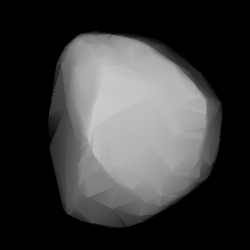150 Nuwa
 3D convex shape model of 150 Nuwa | |
| Discovery | |
|---|---|
| Discovered by | J. C. Watson |
| Discovery date | 18 October 1875 |
| Designations | |
| (150) Nuwa | |
| Pronunciation | /ˈnjuːwɑː/[citation needed] |
Named after | Nüwa |
| A875 UA; 1908 AL; 2002 JR70 | |
| Main belt | |
| Orbital characteristics[1] | |
| Epoch 31 July 2016 (JD 2457600.5) | |
| Uncertainty parameter 0 | |
| Observation arc | 116.94 yr (42714 d) |
| Aphelion | 3.3586 AU (502.44 Gm) |
| Perihelion | 2.6084 AU (390.21 Gm) |
| 2.9835 AU (446.33 Gm) | |
| Eccentricity | 0.12573 |
| 5.15 yr (1882.3 d) | |
| 138.03° | |
| 0° 11m 28.536s / day | |
| Inclination | 2.1937° |
| 206.21° | |
| 151.84° | |
| Physical characteristics | |
| Dimensions | 151.13±4.5 km[1] 146.54 ± 9.15 km[2] |
| Mass | (1.62 ± 0.20) × 1018 kg[2] |
Mean density | 0.98 ± 0.22 g/cm3[2] |
| 8.14 hours[3] 8.1347 h (0.33895 d)[1][4] | |
| 0.0395±0.002 | |
| C[5] | |
| 8.23 | |
150 Nuwa is a large main-belt asteroid with an orbital period of 5.15 years. It was discovered by Canadian-American astronomer James Craig Watson on 18 October 1875,[6] and named after Nüwa, the Chinese creator goddess. This object is a candidate member of the Hecuba group of asteroids that orbit near the 2:1 mean-motion resonance with Jupiter.[7] Based upon the spectrum it is classified as a C-type asteroid,[8] which indicates that it is probably composed of primitive carbonaceous chondritic material and the surface is exceedingly dark.
Photometric observations of this asteroid at the Catania Astrophysical Observatory during 1992 and 1993 gave a light curve with a period of 8.140 ± 0.005 hours.[3] In 2004, an additional photometric study was performed at Swilken Brae Observatory in St Andrews, Fife, yielding a probable period of 8.1364 ± 0.0008 hours and a brightness variation of 0.26 ± 0.03 in magnitude.[9] A 2011 study from Organ Mesa Observatory in Las Cruces, New Mexico gave a period of 8.1347 ± 0.0001 hours with a brightness variation of 0.17 ± 0.02 magnitude, which is consistent with prior results.[4]
On 17 December 1999, a star was occulted by Nuwa.[citation needed]
References
[edit]- ^ a b c Yeomans, Donald K., "150 Nuwa", JPL Small-Body Database Browser, NASA Jet Propulsion Laboratory, retrieved 12 May 2016.
- ^ a b c Carry, B. (December 2012), "Density of asteroids", Planetary and Space Science, 73 (1): 98–118, arXiv:1203.4336, Bibcode:2012P&SS...73...98C, doi:10.1016/j.pss.2012.03.009. See Table 1.
- ^ a b Blanco, C.; et al. (February 1996), "Lightcurves, pole direction and shape of asteroids 121 Hermione, 150 Nuwa, 236 Honoria, 287 Nephthys and 377 Campania", Planetary and Space Science, 44 (2): 93–106, Bibcode:1996P&SS...44...93B, doi:10.1016/0032-0633(95)00097-6.
- ^ a b Pilcher, Frederick (July 2011), "Rotation Period Determinations for 28 Bellona, 81 Terpsichore, 126 Velleda, 150 Nuwa, 161 Athor, 419 Aurelia, and 632 Pyrrha", The Minor Planet Bulletin, 38 (3): 156–158, Bibcode:2011MPBu...38..156P.
- ^ Richmond, Michael, Asteroid Lightcurve Data File, Updated March 1, 2001, retrieved 3 April 2013.
- ^ "Numbered Minor Planets 1–5000", Discovery Circumstances, IAU Minor Planet center, retrieved 7 April 2013.
- ^ McDonald, Sophia Levy (June 1948), "General perturbations and mean elements, with representations of 35 minor planets of the Hecuba group", Astronomical Journal, 53: 199, Bibcode:1948AJ.....53..199M, doi:10.1086/106097.
- ^ DeMeo, Francesca E.; et al. (July 2009), "An extension of the Bus asteroid taxonomy into the near-infrared" (PDF), Icarus, 202 (1): 160–180, Bibcode:2009Icar..202..160D, doi:10.1016/j.icarus.2009.02.005, archived from the original (PDF) on 17 March 2014, retrieved 8 April 2013. See appendix A.
- ^ Vincent, Fiona (August 2006), "The lightcurve of (150) Nuwa", Journal of the British Astronomical Association, 116 (4): 200–202, Bibcode:2006JBAA..116..200V.
External links
[edit]- Image taken on 25, 26, 27 September 2009 from Slooh Robotic Telescope (Teide - Canary Islands): "Title Unknown". Archived from the original on 14 July 2011. Retrieved 5 October 2009.
- Image taken on 3 October 2009 from Slooh Robotic Telescope (Teide - Canary Islands):"Title Unknown". Archived from the original on 14 July 2011. Retrieved 6 November 2009.
- Image taken on 23 October 2009 from Slooh Robotic Telescope (Teide - Canary Islands): "Title Unknown". Archived from the original on 14 July 2011. Retrieved 6 November 2009.
- 150 Nuwa at AstDyS-2, Asteroids—Dynamic Site
- 150 Nuwa at the JPL Small-Body Database


 French
French Deutsch
Deutsch